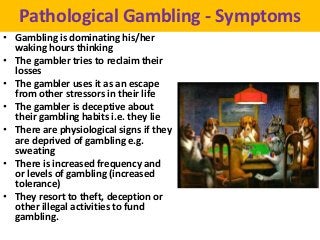
Pathological gambling - dopamine reward system
- 1. Pathological Gambling - Symptoms • Gambling is dominating his/her waking hours thinking • The gambler tries to reclaim their losses • The gambler uses it as an escape from other stressors in their life • The gambler is deceptive about their gambling habits i.e. they lie • There are physiological signs if they are deprived of gambling e.g. sweating • There is increased frequency and or levels of gambling (increased tolerance) • They resort to theft, deception or other illegal activities to fund gambling.
- 3. Application of Biopsychosocial framework to understanding an addictive disorder: Gambling 1: Biological Factors: The role of the dopamine reward system • Dopamine is a neurotransmitter found in the Central.N.S • Responsible for the ‘pleasure centre in the brain’ • To satisfy the desire for pleasure, the person will repeat the behaviour to cause the release of dopamine e.g. food & sex • But dopamine is also released when something pleasurable yet unexpected occurs • After the first time, the person expects the effect, thus less dopamine is released, and the experience is less satisfying
- 4. Biological Factors: The role of the dopamine reward system • The dopamine reward system can be triggered by various environmental cues e.g.. a ‘pop-ad’ that comes online, driving past a tabaret venue, TV ad, etc. • The anticipation of the reward (a ‘win’) triggers the dopamine reward system • These feelings of satisfaction that dopamine exhibits are so strong that one can often loses one's ability to reason in order to achieve satisfaction • The brain develops neural circuits that unconsciously assess reward because the dopamine plays an active role in these circuits, a person will act in what they think is in their best interest, when in fact the only interest it satisfies is the release of dopamine. • Probability and reason no longer are the most important factors in decision making. The unconscious need for the release of dopamine becomes most important.
- 5. Random Ratio Schedule of reinforcement • The use of a random ratio schedule reinforcement is a key fact of the addictive behaviour because the outcome is based on chance, one does not know prior if he or she will win. Therefore, if the person one wins, dopamine levels increase. The good news it that gambling causes addiction in only 4% of participants. Therefore, only people whose dopamine levels are low, become addicted to gambling
- 6. Naltrexone • Naltrexone blocks the uptake of dopamine a the postsynaptic neuron by having an inhibitory (antagonistic) effect at the synapse • Thus decreasing subjective feelings of pleasure and the impulsive need to satisfy the urge to get that ‘high’ from a win.
Notas del editor
- Naltrexone has an antagonistic effect, by blocking uptake of dopamine at the post-synaptic neuron.
- Naltrexone has an antagonistic effect, by blocking uptake of dopamine at the post-synaptic neuron.
- Naltrexone has an antagonistic effect, by blocking uptake of dopamine at the post-synaptic neuron.
